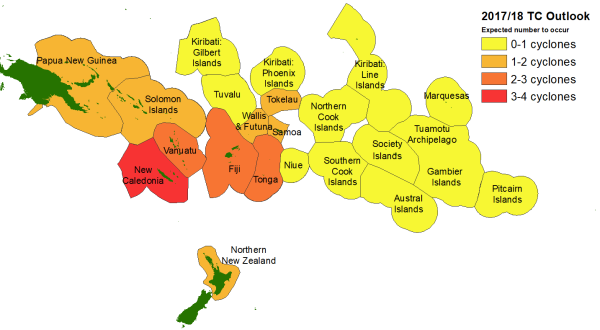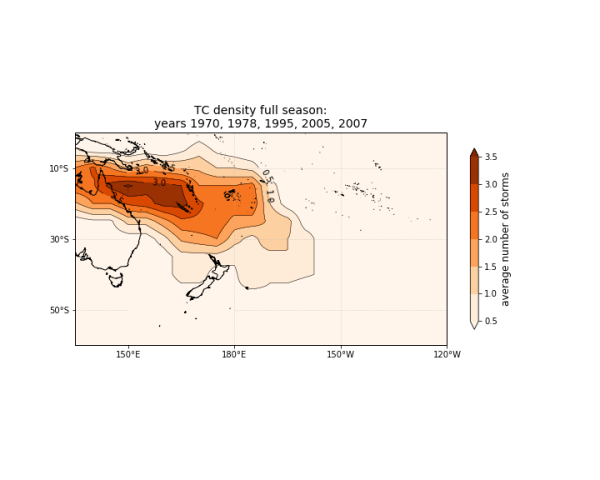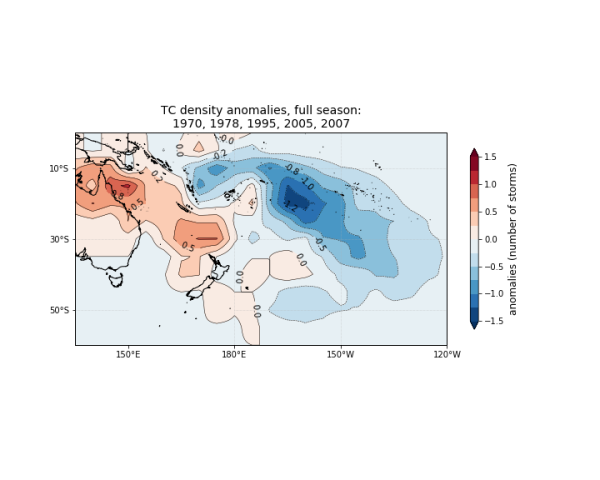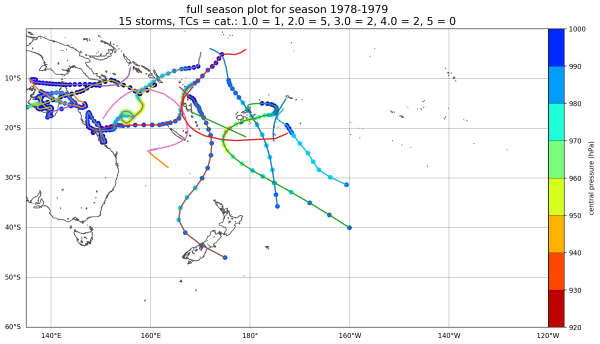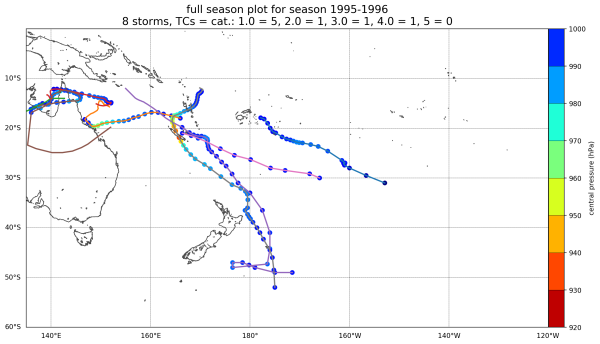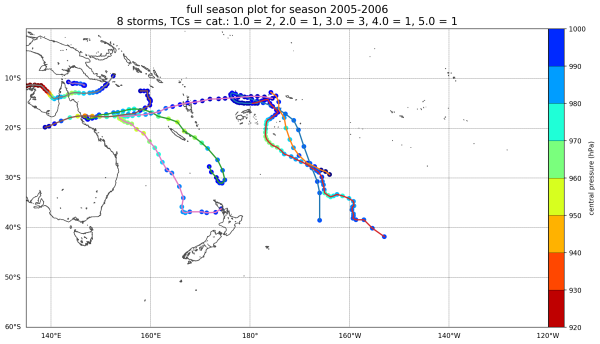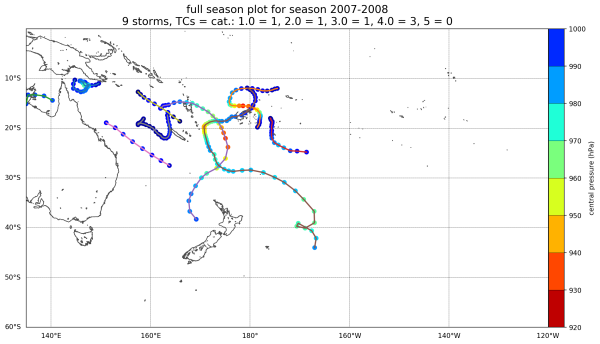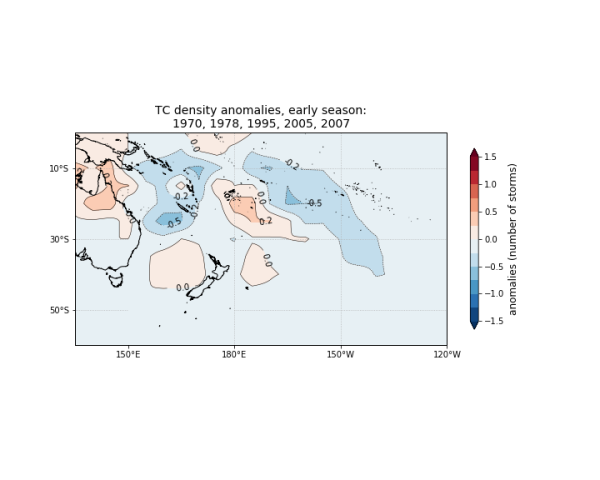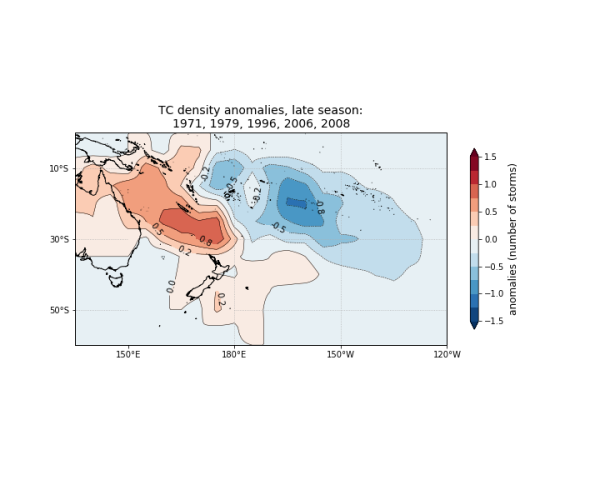Southwest Pacific Tropical Cyclone Outlook: Near-normal season expected, but with increased activity west, reduced activity east.
Forecasters say about eight to 10 named tropical cyclones are expected to form in the Southwest Pacific basin between November and April.
Analysis by forecasting centres across the Southwest Pacific show tropical cyclone activity is expected to higher around the Coral Sea and west of the International Date Line, and lower further east.
New Caledonia, Fiji, Vanuatu and Tonga may experience two or more cyclones during the season, while three or four severe cyclones of Category 3 of higher, are expected anywhere across the region during the season that starts next month and lasts until the end of April.
On average, at least one ex-tropical cyclone passes within 550km of New Zealand each year. For the coming season, forecaster say the risk for New Zealand is considered normal or above normal. If an ex-tropical cyclone comes close to the country, it has equal probability of passing east or west of Auckland and the North Island. Significant rainfall, damaging winds and coastal damage can occur leading up to and during these events.
Oceanic and atmospheric forecasts for ENSO (El Niño-Southern Oscillation) indicate La Niña conditions are expected to develop by summer. At present, sea surface temperature anomalies across the central and eastern equatorial Pacific Ocean and atmospheric circulation patterns over French Polynesia and northern Australia indicate conditions are ENSO-neutral, but leaning toward La Niña.
If La Niña conditions develop, they are likely to result in a significant change from normal tropical cyclone activity in many Pacific Islands.
Islands on the fringe of the north Coral Sea, including Papua New Guinea, the Solomon Islands, Vanuatu, New Caledonia and Tonga may experience slightly increased activity. Reduced activity is expected in some islands, especially those east of 160°W longitude, including the Cook Islands, the Marquesas and French Polynesia.
Tropical cyclones are categorised in strength from 1 to 5, with 5 being the most intense. For the coming season, about four storms are anticipated to reach at least Category 3, with mean wind speeds of at least 118 km/h winds). Of these, two may increase to at least Category 4 strength, with mean wind speeds of 159 km/h. Category 5 strength cylcones where winds are greater than 196 km/h, have occurred during seasons with similar antecedent conditions to 2017/18 (known as ‘analogue’ seasons). Therefore, all communities should remain alert and well-prepared for severe events.
Tropical cyclones have a significant impact across the Southwest Pacific. Vanuatu and New Caledonia typically experience the greatest activity, with an average of two or three named cyclones passing close to land each year.
New Zealand should also be vigilant. During some analogue seasons used in the preparation of this outlook, multiple ex-tropical cyclones passed within 550 km of the country. Significant wind, waves and rainfall are possible from these systems. Their effects can be spread over a larger area, particularly if the ex-tropical cyclone interacts with separate weather systems.
Tropical cyclone activity is expected to be reduced for some countries during this season, especially for islands to the east of 160°W longitude, including the Cook Islands, the Marquesas and French Polynesia. As with most years, activity is expected to increase during the second half of the season, from February-April.
All Pacific Islands should remain vigilant in case conditions in the equatorial Pacific (including ENSO) change during the season. Analogue seasons have seen intensification to well-coupled La Niña conditions and strong increases in storm activity west of the Dateline in the late season. NIWA, MetService, MeteoFrance, BoM, NOAA and Pacific Island National Meteorological Services will all continue to track the progression of ENSO and there will be an update to this guidance in January 2018 if needed.
New Zealand’s National Institute of Water & Atmospheric Research (NIWA) and Meteorological Service of New Zealand (MetService) along with contributions from meteorological forecasting organizations from the Southwest Pacific, including the Australian Bureau of Meteorology, MeteoFrance and the Pacific Island National Meteorological Services have prepared this tropical cyclone outlook.
Contacts
In New Zealand:
Mr. Chris Brandolino - Principal Scientist - Forecasting, NIWA Tel: +64 9 375 6335
Mr. Chris Noble - Manager, Specialist Weather Services, MetService New Zealand Tel: +64 4 470 1175
Mrs. Elke Louw - Wellington RSMC (Regional Specialized Meteorological Centre), Manger, Marine Weather Services, MetService New Zealand Tel: +64 4 470 0737
Mr. Ben Noll - Forecaster, NIWA Tel: +64 9 375 6334
In the Pacific Islands, please contact your local national meteorological service for information about how this guidance should be interpreted.
For Australia and associated offshore islands, please contact the Australian Bureau of Meteorology for information about how this guidance should be interpreted.
For French Polynesia and New Caledonia, please contact MeteoFrance for information about how this guidance should be interpreted.
Additional background information
Modern analogue guidance:
TCs in the Southwest Pacific usually develop between November and April, but occasionally they can occur in October and May, very rarely in June – August. An analysis of past TC tracks in the SW Pacific indicate they are exceptionally unlikely in September.
Peak TC season is usually from January to March. In seasons with similar background climate conditions to the present, TC activity was elevated in a zone situated west of the International Dateline from the Coral Sea southeast across the north Tasman Sea and north of New Zealand. In addition, the strongest TC anomalies were focused in the region between Papua New Guinea and the north Queensland coastline, which is associated with a southwest displacement of the South Pacific Convergence Zone (SPCZ) during La Niña events. There is also a small region of increased TC incidence near Tonga and more broadly to the north and west of New Zealand's North Island. On average, nearly half of the TCs that developed since the 1969-70 season have reached hurricane force with mean wind speeds of at least 64 knots (118 km/h).
To find past analogues that describe the climate state leading into the upcoming TC season, the past May-September conditions were examined for the tropical Pacific from 1969 to the present. For most of winter and early spring 2017, the ENSO system was in an ENSO-neutral state, but has now leaned toward La Niña. Available information from international forecasting centres that issue global climate forecast model outputs and ENSO diagnostics are integrated by NIWA’s National Climate Centre. The collective guidance suggests El Niño is not likely, and La Niña is expected develop by the end of spring/early summer. As such, an additional element used to select the TC analogue seasons included tracks that occurred when some form of moderate La Niña formed during spring and persisted into austral summer.
We used a joint ENSO index that combines the Southern Oscillation Index (SOI) with the most widely-used oceanic index of sea surface temperature anomalies in the equatorial central-western Pacific (NINO3.4). This joint ENSO index is described in Gergis and Fowler (2005) as the “Coupled ENSO Index” (CEI). Using the CEI, we selected analogue TC seasons for the 2017-18 forecast. We highlighted seasons when the equatorial SSTs and the SOI were indicative of a transition from ENSO-neutral conditions to weak or moderate La Niña conditions.
Five analogue TC seasons (1970/71; 1978/79; 1995/96; 2005/06; 2007/08) typified the antecedent ENSO development and our expectations for the coming season based on international ENSO forecasts. Note that the small number of analogue seasons relates to the high-quality TC data period in the satellite era beginning in 1969/70 (only 47 seasons), the availability of TC track data (current only to the end of the 2016/17 season), and the limited number of similar analogues to this season. As such, the tropical cyclone guidance for November 2017 to April 2018 is built on the five analogue seasons identified above.
NIWA’s SW Pacific TC outlook spans four areas of responsibility overseen by international monitoring and forecast agencies (RMSC Nadi, TCWC Brisbane, TCWC Port Moresby and TCWC Wellington). We used a high-quality set of past TC tracks from the South Pacific Enhanced Archive of Tropical Cyclones (SPEArTC) (Diamond et al., 2012) which covers 135°E to 120°W longitude to draw on past TC track patterns for this seasonal outlook. This region encompasses a basin that is defined by climatology rather than geopolitical or meteorological boundaries (Diamond et al., 2012). Southwest Pacific islands fringing the north Coral Sea, including Papua New Guinea and the Solomon Islands and those nations situated adjacent to and west of the International Date Line including Tonga and New Caledonia (and the region to the south of those nations) are expected to see elevated activity (Table 1; Figure 2 & 3). Tuvalu is expected to experience normal or below normal activity for a TC interaction. The main TC genesis region is expected to lie within a band between 10 – 12°S (north of Vanuatu) well to the west of the International Date Line. Most of the analogue seasons we have identified experienced Category 4 tropical cyclones. A total of 9 named storms on average are expected this coming season; the range of variation between analogue seasons suggests 8 to 10 could occur for the total TC count (all named storms) within the TC outlook area, which is close to normal.
Previous TC research has indicated storm track sinuosity is diminished during La Niñas (Malsale, 2011). This means that many tropical cyclone tracks for the coming season may have more linear trajectories than normal. Past tracks for years like the present tended to cover a zone ranging from a genesis region north and just west of northern Vanuatu, and extra-tropical transition (ETT) due south of Fiji (mean longitude of ~177°E upon TC exiting the tropics at 25°S). For the historical TC tracks for the selected analogue seasons, there is a very large spread for the location where each system underwent ETT that presents significant uncertainties for maritime navigation risks.
A split of the analogue TC seasons into early (November – January) and late (February – April) periods suggests TC activity will be close to normal for the early part of the TC season (Figure 4), except for two slightly elevated activity regions that encompass the Gulf of Carpentaria and the north Coral Sea, and southeast of Fiji. Activity in general is expected to increase during the late season and the spatial anomalies for this TC outlook strongly indicate increased risk of storms in the region south and southwest of the Solomon Islands and Vanuatu, with reduced risk near Fiji, Samoa, the Southern Cook Islands and other islands east of the International Date Line.
TC intensity is partly related to how long developing cyclonic systems reside in the tropics and gain support for their growth from underlying warm waters. In addition, the subtropical jet and South Pacific Convergence Zone (SPCZ) mutually interact and contribute to shear during extra-tropical transition. It should also be noted that the interplay of a hemispheric-scale atmospheric circulation with the timing of the short-term Madden-Julian Oscillation (MJO) passage (typically on a 30 to 50-day cycle) has significant bearing on TC activity in the region. Increased and more intense TC activity can be expected during the MJO 6-7 paired phase (Diamond and Renwick, 2015). Real-time monitoring of the MJO is available from the Australian Bureau of Meteorology at http://www.bom.gov.au/climate/mjo/.
Previous work (Lorrey et al., 2013) indicates New Zealand interacts with at least one ex-tropical cyclone passing within 550 km of the country every year. For the coming TC season, the risk for New Zealand is close to normal, but is expected to become elevated to above normal for the late season. If an ex-tropical cyclone passes close to the country, it has an equal probability of passing east (or west) of Auckland city based on the historic tracks selected for this outlook and the expected state of ENSO in the coming season.
Weekly statistical forecasts of TC genesis and TC activity for the SW Pacific basin are produced by MeteoFrance based on phasing of the MJO (Leroy and Wheeler, 2008). This guidance is useful for sub-monthly scale regional tropical cyclone guidance, and can be found at: http://www.meteo.nc/espro/previcycl/cyclA.php.
Dynamical climate model guidance
There is strong agreement amongst long-range global dynamical models that rainfall between November 2017 and April 2018 will be normal or above normal between 10° to 20°S and 150°E to 150°W. This region includes New Caledonia, Vanuatu and west of Fiji.
The European Centre for Medium-Range Weather Forecasts (ECMWF) seasonal TC guidance indicates above normal tropical cyclone density east of the central and southern Queensland coast, east of New Caledonia across to Fiji and in the region near Norfolk Island. Tropical storm frequency is forecast to be below average in the ECMWF SW Pacific domain (160°E-120°W; 4.4 TC’s versus 5.7). Reduced tropical cyclone density anomalies are forecast from the eastern Arafura Sea eastward to Tokelau. This guidance also indicates severe TC occurrence is expected to be near normal. The ECMWF seasonal forecast of accumulated cyclone energy (ACE) indicates near normal values for the coming season.
Collectively, this guidance supports near average tropical cyclone activity for the Southwest Pacific basin for the 2017/18 tropical cyclone season. There is a suggestion from the dynamical models that tropical cyclone activity could be close to the long-term average for the SW Pacific basin (135°E-120°W). However, the expectation for tropical cyclone activity indicates more concentrated tracks between 150°E and 150°W when compared to the long-term average TC occurrences.
Based on the dynamical seasonal rainfall predictions and the ECMWF seasonal tropical cyclone guidance, there is an elevated risk that one (1) or more ex-tropical cyclone(s) may pass within 550 km of Auckland City.
NB: The ECMWF forecast domain is from 160°E to 120°W. The SW Pacific basin covers 135° to 120°W, thus the SW Pacific forecast generated by NIWA and colleagues extends 25° westward than the ECMWF forecast domain.
References
Gergis, J., and A. M. Fowler, 2005. Classification of synchronous oceanic and atmospheric El Niño–Southern Oscillation (ENSO) events for palaeoclimate reconstruction. International Journal of Climatology, 25: 1541–1565.
Diamond, H.J., and J.A. Renwick, 2015. The climatological relationship between tropical cyclones in the southwest Pacific and the Madden-Julian Oscillation. International Journal of Climatology, 35: 676-686. doi: 10.1002/joc.4012.
Diamond, H.J., A.M. Lorrey, K.R. Knapp, and D.H. Levinson, 2012. Development of an enhanced tropical cyclone tracks database for the southwest Pacific from 1840-2011. International Journal of Climatology, 32: 2240–2250. doi:10.1002/joc.2412.
Diamond, H.J., A.M. Lorrey, and J.A. Renwick, 2013. A Southwest Pacific tropical cyclone climatology and linkages to the El Niño–Southern Oscillation. Journal of Climate, 26(1): 3-25. doi:10.1175/JCLI-D-12-00077.1.
Leroy, A., and M.C. Wheeler, 2008. Statistical prediction of weekly tropical cyclone activity in the Southern Hemisphere. Monthly Weather Review, 136: 3637-3654.
Lorrey, A.M., G. Griffiths, N. Fauchereau, H.J. Diamond, P.R. Chappell, and J. Renwick, 2013. An ex-tropical cyclone climatology for Auckland, New Zealand. International Journal of Climatology, 34: 1157–1168. doi: 10.1002/joc.3753.
Malsale, P. 2011. Analysis of tropical cyclone track sinuosity in the South Pacific region using ARCGIS. Unpublished MSc Thesis, University of the South Pacific. 155 pages.
Figure 2: Number of TCs occurring for the main development season (November – April) in the Southwest Pacific (135°E to 120°W): (top panel) average number during 1981 to 2010 (normal); (centre panel) average number over selected five analogue seasons (Table 1); (bottom panel) departure from normal for the analogue seasons (difference between count in centre and top panels). For each year noted, that represents the start of the main development season (i.e. 1969 = November 1969-April 1970)
Table 1: The average number of TCs passing close to the main South Pacific Island groups between November and April. The activity associated with some island groups for the coming season is a subjective assessment, and has been stated to be consistent with the wishes of the national meteorological services involved in generating this regional forecast. In addition, subjective qualification of activity (and associated risk) also recognises the small differences between the actual TC counts for the analogue composites and climatological values. The table is therefore only generally indicative of how many storms might be expected for any given island group for the coming season.
|
Country/ |
Climatology |
Analogue seasons |
Anomaly |
% Difference |
Risk |
|
Territory |
|
|
|
|
|
|
New Caledonia |
2.75 |
3.25 |
0.5 |
20 |
normal-above |
|
Vanuatu |
2.9 |
2.7 |
-0.2 |
-10 |
near normal |
|
Tonga |
2.2 |
2.5 |
0.3 |
15 |
normal-above |
|
Fiji |
2.5 |
2.3 |
-0.2 |
-10 |
near normal |
|
Wallis & Futuna |
2.2 |
1.5 |
-0.7 |
-30 |
below |
|
Solomon Is. |
1.2 |
1.2 |
0 |
0 |
normal |
|
Samoa |
1.7 |
1.2 |
-0.5 |
-30 |
below |
|
N. New Zealand |
0.75 |
1.2 |
0.45 |
60 |
normal-above |
|
Papua New Guinea |
0.9 |
1.1 |
0.2 |
20 |
normal-above |
|
Tokelau |
1.6 |
1.1 |
-0.5 |
-30 |
below |
|
Niue |
1.8 |
1 |
-0.8 |
-45 |
below |
|
Tuvalu |
1.4 |
0.8 |
-0.4 |
-40 |
below |
|
Austral Is. |
0.75 |
0.75 |
0 |
- |
unlikely |
|
S. Cooks |
1.3 |
0.3 |
-1 |
-75 |
below |
|
W. Kiribati |
0.1 |
0.3 |
0.25 |
- |
unlikely |
|
N. Cooks |
0.5 |
0.25 |
-0.25 |
- |
unlikely |
|
Society Is. |
0.7 |
0 |
-0.7 |
- |
unlikely |
|
Tuamotu |
0.2 |
0 |
-0.2 |
- |
unlikely |
|
Pitcairn |
0 |
0 |
0 |
- |
unlikely |
|
E. Kiribati |
0 |
0 |
0 |
- |
unlikely |
|
Marquesas |
0.1 |
0 |
0 |
- |
unlikely |
Table 2: Previous analogue seasons and intensity of TCs and storms that occurred in the Southwest Pacific.
|
Season |
Number of named storms |
Right: TC category (BoM scale) |
Cat 1 |
Cat 2 |
Cat 3 |
Cat 4 |
Cat 5 |
|
1970/71 |
8 |
3 |
4 |
1 |
0 |
0 |
|
|
1978/79 |
10 |
1 |
5 |
2 |
2 |
0 |
|
|
1995/96 |
8 |
5 |
1 |
1 |
1 |
0 |
|
|
2005/06 |
8 |
2 |
1 |
3 |
1 |
1 |
|
|
2007/08 |
6 |
1 |
1 |
1 |
3 |
0 |
|
|
Mean total |
8 |
2.4 |
2.4 |
1.6 |
1.4 |
0.2 |
|
|
Rounded mean totals |
8 |
2 |
2 |
2 |
1 |
1* |
Analogue guidance summary:
Based on the guidance NIWA has generated, 8-10 named TCs are expected for the 2017-18 season for the Southwest Pacific basin (135° E – 120° W). The spread for the estimated storm activity comes from the variation between selected analogue seasons. The historic average is just over 10 named cyclones per season for the basin, indicating near normal or slightly below normal activity could occur for this coming season across the SW Pacific islands.
Potentially, a combination of up to four cyclones may reach category 3 or higher status. The long-term TC climatology (last 46 seasons) and the analogues we have identified suggests the occurrence of a Category 5 system is not highly likely* (see Table 2), but analysis of historic observations indicate a storm of this magnitude could occur. All the historic analogues selected for the 2017-18 outlook indicate multiple severe TCs equivalent or greater than Category 3 occurred in seasons similar to the present. This lends a moderate-to-high degree of confidence in the outlook for storm strength.
For the selected analogues, all years show one or two ex-tropical cyclones came within 550 km of New Zealand. The rounded average interaction for New Zealand is 2 named storms. Some of these storms also made landfall, with a majority of ex-tropical cyclone interactions occurring during the latter half of the TC season (February-April). Some of the decaying systems were also associated with high rainfall, damaging winds and amplified coastal wave conditions. The risk of an interaction for New Zealand (at least one storm coming within 550 km of the country) for the 2017-18 season is slightly above normal. There is an equal probability of a decaying ex-tropical cyclone tracking to the east or west of the North Island.
Figure 3: Plots of TC tracks and major storms that were monitored for analogue seasons used in the 2017-18 seasonal forecast for the full season (November - April). Track data are courtesy of the South Pacific Enhanced Archive for TC research (SPEArTC).
Figure 4: Early season (November to January) and late season (February to April) anomaly plots for selected TC analogue seasons (data courtesy of South Pacific Enhanced Archive for Tropical Cyclone research (SPEArTC). The year label notes the first month in the analogue selection (i.e. for the early season 1970 = November 1970, December 1970, January 1971; and for the late season 1971= February – April 1971).


